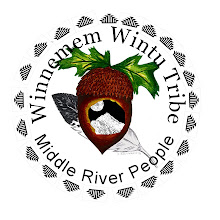New Zealand Salmon
I would like to thank all of the folks who have offered support and donated to the Tribe's ceremony for the salmon living on the Rakaia River.
Currently, the USF&WS as well as NOAA have been working on a salmon restoration project to return salmon to the waters above the impoundment dams on the west coast. When I spoke with them at a meeting in Sacramento, they were surprised that the genetic stock from the McCloud Baird hatchery were thriving in the rivers of New Zealand. This information was what they had hoped for as the original stock fish are what the projects call for. By bringing the roe of the ancestors of the McCloud fish home, we hope to reverse the decline of salmon we all are suffering from.
Anyway, the video link for youtube, http://www.youtube.com/winnememwintu#p/u/0/n1iMcEwb0BI is a short description of the ceremony and its importance (along with some other discussion, we made in Eugene Oregon this week for the PIELC law conference. We hope you enjoy it and it answers some of your questions about why we are headed to the Pacific.
Currently, the USF&WS as well as NOAA have been working on a salmon restoration project to return salmon to the waters above the impoundment dams on the west coast. When I spoke with them at a meeting in Sacramento, they were surprised that the genetic stock from the McCloud Baird hatchery were thriving in the rivers of New Zealand. This information was what they had hoped for as the original stock fish are what the projects call for. By bringing the roe of the ancestors of the McCloud fish home, we hope to reverse the decline of salmon we all are suffering from.
Anyway, the video link for youtube, http://www.youtube.com/winnememwintu#p/u/0/n1iMcEwb0BI is a short description of the ceremony and its importance (along with some other discussion, we made in Eugene Oregon this week for the PIELC law conference. We hope you enjoy it and it answers some of your questions about why we are headed to the Pacific.







